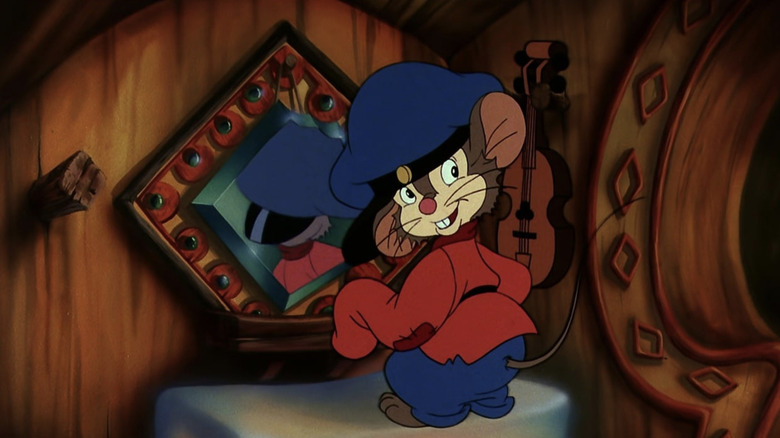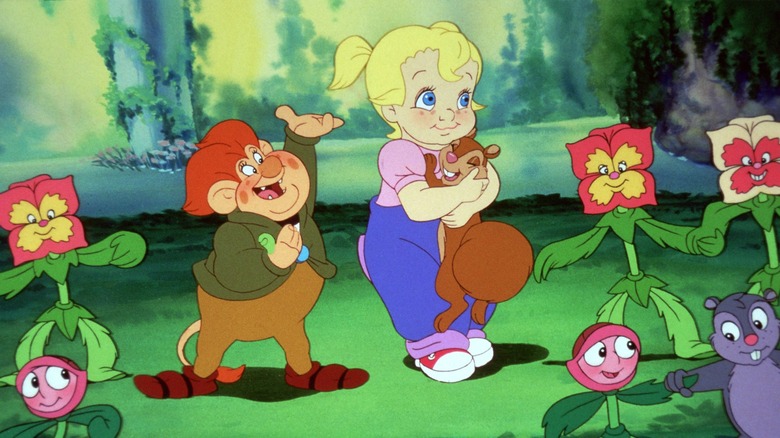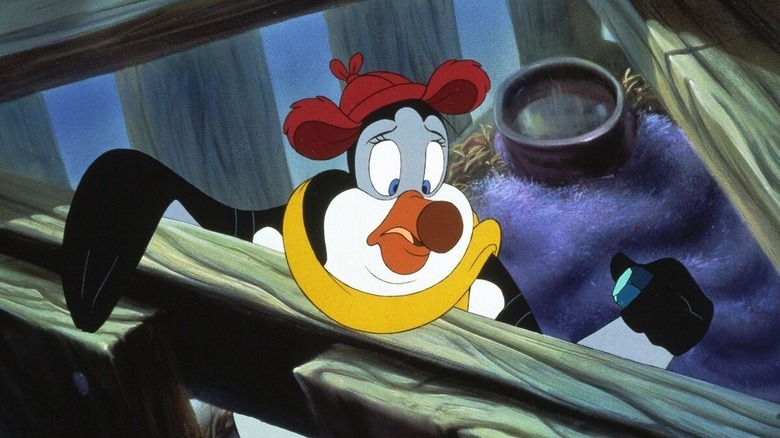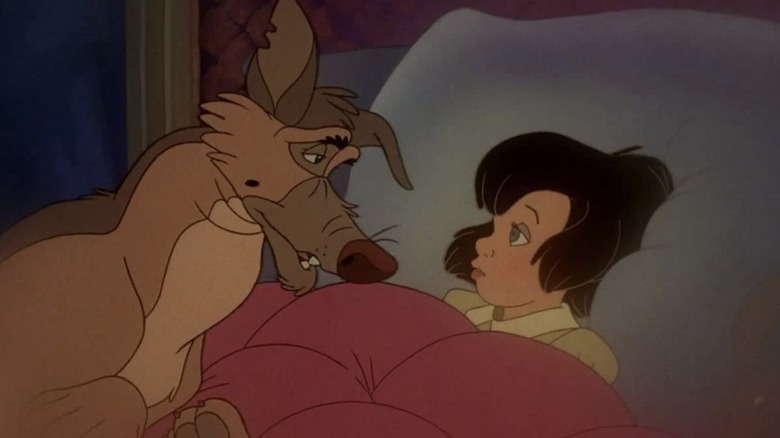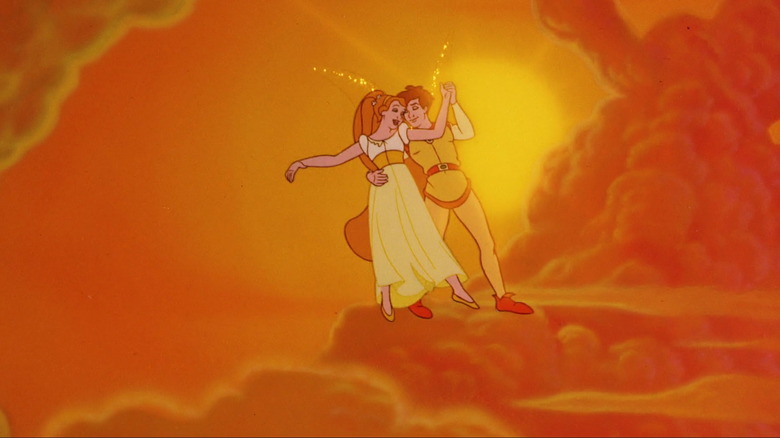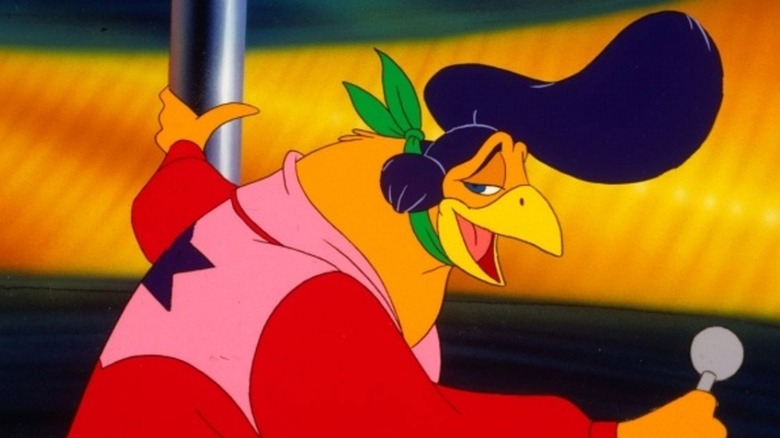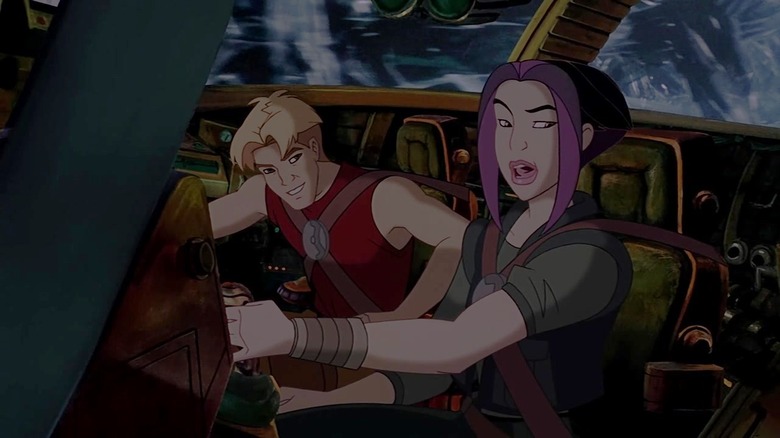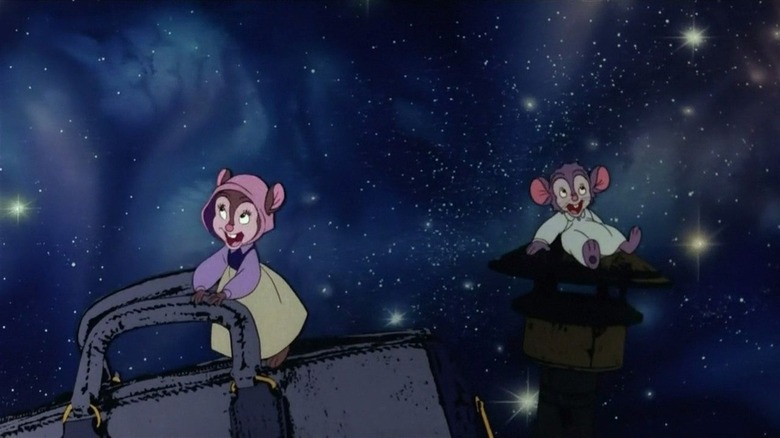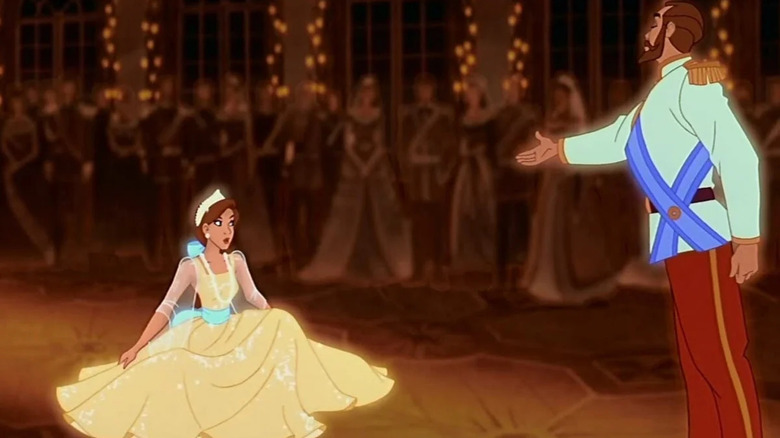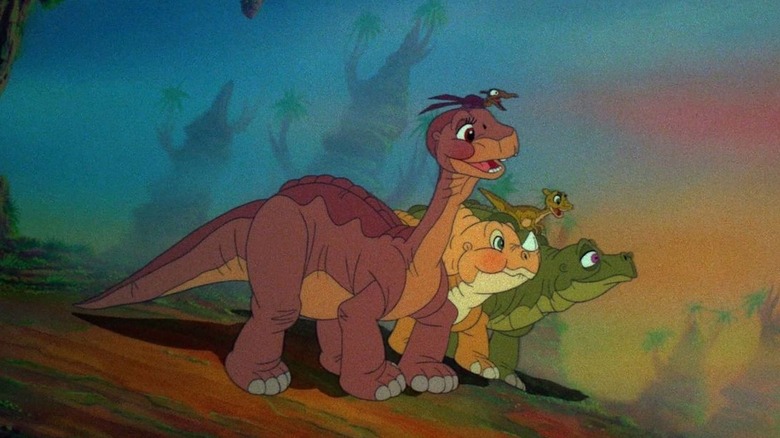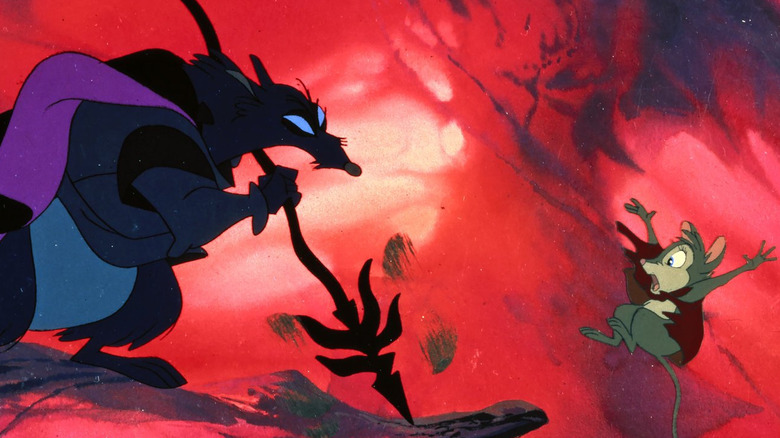Every Don Bluth Movie, Ranked
There's nothing like a Don Bluth animated film. From the wide-eyed whimsy of his characters to his confusing, dreamlike sequences, the work of this animation icon has delighted (and terrified) audiences since the release of "The Secret of NIMH." Some 40 years later, Bluth's filmography has grown to contain some of the most fascinating hand-drawn animated projects Hollywood has ever seen. From nostalgic classics like "An American Tail" and "The Land Before Time" to truly odd flops like "A Troll in Central Park" and "Rock-a-Doodle," the list goes on and on. That begs the question, which films rank as the best examples of Bluth's talents?
From the not-so-great to the ones that continue to make us smile, we'll dive deep into Don Bluth's theatrically released feature films. Sure, there are projects he worked on outside of that specific medium (including direct-to-video projects and video games) To correctly examine this filmmaker, it's best to look at the big-time projects that made him a household name. Let's dust off the VCR and crack open our clamshell VHS collection to discover which of Don Bluth's movies are still delightful pieces of nostalgia.
A Troll in Central Park
If you were a kid of the '90s that happened to pick "A Troll in Central Park" as your weekend rental, then you might be puzzled to see it so low on the list. Sure, it has a whimsical color palette and the pleasing vocal talents of Dom DeLuise, but despite your nostalgia for the magical troll that brings flowers to life, this film is a downright mess.
First, "A Troll in Central Park" has absolutely no plot. The story feels like it begins in the middle and leaves most elements (including why some characters have magical thumbs and some don't) a total mystery. It also doesn't help that two of the main characters are a toddler and her slightly older brother, which while cute in some sequences, are agonizing in others.
Yet, the movie's biggest crime is its wasted potential. Maybe it's Stanley's (DeLuise) sparkly eyelashes or his desire to find acceptance with "a patch of green," but it's easy to see that this movie is trying to say something more interesting about inclusion than what ended up in the film. Still, knowing Bluth's disdain for the end product and its poor reception, it's no wonder "A Troll in Central Park" is the non-sensical flop it is today.
The Pebble and the Penguin
Another Don Bluth and Gary Goldman co-production, 1995's "The Pebble and the Penguin" is often remembered more for its behind-the-scenes drama (including Bluth and Goldman leaving the project after frustrations with MGM) than the film itself. Despite its box office troubles and less-than-stellar reviews, it's a movie with a lot more going for it than "A Troll in Central Park" does.
From its fascinating (albeit confusing) penguins-turning-into-musical notes opening sequence to its campy but catchy score by Barry Manilow, the film contains some charms that keep it from being a total disaster. This is particularly true of the voice cast, including Martin Short as the heroic yet awkward Hubie and Annie Golden as the delightful Marina, who are all trying their best to work with what they were given.
The thing that weighs "The Pebble and the Penguin" down is its obsession with trying to top what Disney had done a few years prior. From the clear influence of "Beauty and the Beast's" Gaston on Tim Curry's character, Drake, to the frustrating comedic sequences between Hubie and his rough-around-the-edges friend, Rocko (Jim Belushi), the movie ultimately feels like the result of rivalry rather than a genuine piece of creativity. Considering Bluth's history with the House of Mouse, it feels all the more frustrating to notice.
All Dogs Go to Heaven
Though some Don Bluth projects contain an overall sweetness, a few are filled with more dark than light. For example, take the mixed bag that is "All Dogs Go to Heaven," a movie that, while visually fascinating, is downright horrifying. When your film centers on a criminal dog trying to escape going to hell while simultaneously involving a little orphan girl in a gambling ring, let's just say it's hard to feel any warmth towards its narrative.
This isn't helped by the film's ensemble of mostly unlikable characters. Charlie, our lead dog (voiced by Burt Reynolds), has about as much charm as a cold meal at Applebees. Yes, Reynolds provides some tender moments during the film's emotional conclusion, but before the finale, there's a lot of evidence that makes it easy to wish for Charlie's downfall. Plus, Dom Deluise's Itchy is more of a jerk than an adorable sidekick, Vic Tayback's Carface is utter nightmare fuel, while Loni Anderson's Flo is the only sensible character in the movie.
Despite the film's treasure trove of unpleasantries, it's hard to deny the effort and creativity Bluth and his team put into the project. Certain shots are stunning, while specific scenes (like the iconic Alligator moment) warrant a place in animation history. It's just a shame that these elements are paired with such a frustrating story and some of the worst music in Bluth's filmography.
Thumbelina
When it comes to Don Bluth movies, "Thumbelina" is the best example of the director playing it safe. Released in 1994, it came out during the height of Disney's Renaissance, the time when "Beauty and the Beast," "Aladdin," and many other romantically charged, fairytale-inspired movies from the House of Mouse were dominating the box office. It makes sense that Bluth and co-director Gary Goldman wanted a piece of the princess merchandise-driven pie. Unlike "Anastasia," "Thumbelina" has many more odd elements by comparison.
Despite casting a literal Disney princess ("The Little Mermaid's" Jodi Benson) as the titular character, Thumbelina herself isn't all that intriguing. Sure, Benson brings a lot to what is otherwise a very forgettable fantasy heroine, but it's a shame that Bluth and Goldman couldn't have given her a more exciting personality. Similarly, the rest of the film's cast of one-note characters and its way-too-fast-paced plot don't make its simple story any more interesting.
However, the animation and hyper-stylized musical sequences make "Thumbelina" rank a bit higher on this list. Yes, "Marry the Mole" is far from noteworthy, but when looking at the "Let Me Be Your Wings" scene and the moment Thumbelina describes the sun, it's clear the team at Don Bluth Ireland Ltd. tried to make this movie something special. Did every aspect of it succeed? Sadly, no, but the effort is appreciated.
Rock-a-Doodle
To some, the story of a rooster that has the power to raise the sun might sound quite silly. In the case of Don Bluth's "Rock-a-Doodle" an adaptation of the classic "Chanticleer" tale, that initial concept is made even wackier with the inclusion of a little kid getting turned into a cat and other fascinating narrative choices. With such bizarre elements, it's hard not to admire "Rock-a-Doodle."
Featuring awkward live-action footage combined with 2D animation, this movie is the purest example of Bluth taking many risky swings. Some decisions pay off, like the final battle between Chanticleer (Glen Campbell) and the Grand Duke of Owls (Christopher Plummer), while others don't, including the moment when audiences get to see the inside of Edmond's kitty-human-boy-hybrid brain during an intense car chase. All in all, these moments are the cinematic definition of a mixed bag.
Even with the film's flaws, it's much more interesting to see Bluth take risks with his work than play it safe. He's proven that he's at his best when he "colors outside the lines" (creatively speaking). While "Rock-a-Doodle" is far from a perfect movie, it's entertaining to see Bluth weave a colorful yet clumsy story of a rooster looking to reclaim his dignity.
Titan A.E.
Don Bluth's last feature film, "Titan A.E.," is a science fiction project with ambition. Featuring a screenplay co-written by many people (including Joss Whedon), the movie takes on familiar genre tropes but with a refreshing Bluth vibe. It also contains one heck of a voice cast that includes Matt Damon and Drew Barrymore along with some impressive 2D and 3D animation. It's safe to say it's a movie that, on paper, should have worked.
Unfortunately, "Titan A.E." was a box office flop that took Fox Animation down with it. What made it fail so spectacularly? Well, much like counting how many licks it takes to get to the center of a Tootsie Pop, it's hard to precisely pinpoint the reason for its downfall. Could it have been the mature subject matter not clicking with family audiences? Or were viewers ready for a movie that seemed so unfamiliar compared to the usual animated fare of the time?
When push comes to animated shove, "Titan A.E." was not originally intended to be an animated movie — a fact that is hard to ignore as you watch Bluth's aesthetics clash with the movie's rough sci-fi presentation. Still, it's a movie that deserves more respect than it has been given. In an animation landscape still dominated by princesses and fantasy fluff, "Titan A.E." is a breath of fresh air.
An American Tail
"An American Tail" is a career-defining movie for Don Bluth. Featuring everything from adorable animal characters to exciting commentary on historical events, this story about immigrant mice coming to New York City continues to touch viewers' hearts across the globe. Considering its significance to Don Bluth's legacy and Steven Spielberg's animated work, why isn't this nostalgic classic at the top spot?
For starters, Fievel Mousekewitz (Phillip Glasser) is a protagonist that either you love or cannot stand. Yes, he has the typical big eyes and round cheeks that have become Don Bluth staples. Outside of his adorable design, he evokes the frustrating elements that make immature heroes like Pinocchio a test of patience. There's also the film's central conflict of Fievel getting separated from his family. It's the sort of scenario that can either get tiresome real fast or become anxiety-inducing.
Thankfully, "An American Tail" has many positive aspects that make its less appealing elements easier to endure. From the stunning animation of Don Bluth's talented team of animators to the iconic music of James Horner, it's hard to deny the magic this sweet little movie has in every frame of its 81-minute runtime. It might not be for everyone, but as a piece of art, it's easy to see how this movie made Bluth a household name.
Anastasia (1997)
Let's get this out of the way. "Anastasia" is far from a perfect movie. It's historically inaccurate and certainly has other immensely noticeable problems that have been noticed by critics and viewers ever since its initial release. When you push all that to the side, it's hard to deny the one important thing that "Anastasia" gets right. Unlike "Thumbelina," it nails the Disney princess movie formula in every single way.
Right from the beginning, it is clear that Don Bluth and Gary Goldman learned from their missteps on their previous projects and were able to make something that checked all the princess boxes. First, you have our leading lady, Anya (Meg Ryan), who (with her sassy dialogue and confidence) is much more multi-dimensional than "Thumbelina." Then, there's Dimitri (Jon Cusack), who stands out with some fascinating internal conflict, despite looking like many other Don Bluth boys.
What makes "Anastasia" unique is its music. With songs written by Lynn Ahrens and Stephen Flaherty, each musical sequence is more fantastical than the last. From the epic "Once Upon a December" to the wildly electric "Paris Holds the Key to Your Heart," Bluth brings these songs to life in stunning detail. An aspect that makes "Anastasia" feel like a golden age musical from Hollywood's glittering past.
The Land Before Time
Often described as Don Bluth's take on "Bambi," this tale of a young "longneck" and his quest to find his family has many similarities with Disney's critter drama. However, what makes "The Land Before Time" stand out is the fantastical nature of the creatures within the story. With the help of both Bluth's direction and the voice acting, there's something majestic and otherwordly about Littlefoot and his friends.
"The Land Before Time" ranks so high among Bluth's films because of the restraint he shows compared to his later work. He began to learn a lot working alongside producer Steven Spielberg, and it shows in the film's inventive sequences. From the horror genre influences on Sharptooth to the whimsical simplicity of Littlefoot's birth, each scene shows how confident Bluth had become as a director.
It's also important to note the magic of James Horner's music. It's an addition that acts as the cherry on top of Bluth's cinematic sundae, especially in how it wonderfully juxtaposes the movie's sweetness with its more melancholy elements. The end credits song, "If We Hold On Together," performed excellently by Diana Ross, makes it easy to see how both Horner and Bluth's work has left its mark on audiences' hearts for over three decades.
The Secret of NIMH
Based on the book "Mrs. Frisby and the Rats of NIMH," Don Bluth's feature-length directorial debut "The Secret of NIMH" continues to improve with age. Not only does the animation and its themes stand the test of time, but it's a film that respects the intelligence of its younger audience.
But why does "NIMH" remain the greatest of Bluth's work? It's the Bluth project that never loses its dramatic tension. The struggle of watching the courageous Mrs. Brisby (Elizabeth Hartman ) fight for her family's survival continues to be heartwrenching. With all of their intriguing development, the rats of NIMH remain an intimidating presence. Plus, the film's spookier aspects, including the Great Owl (John Carradine), are still as haunting as ever. Simply put, this movie has yet to run out of steam.
What makes "The Secret of NIMH" such a treasure is Bluth's fantastic directorial eye. Considering that this was his first feature-length project, the detail in many of the film's iconic sequences (including the origins of NIMH) contains the kind of cinematic qualities found in the work of filmmakers like Brian De Palma. Overall, "NIMH" wonderfully shows Bluth's potential and what he could have done in live action if given the right material.
